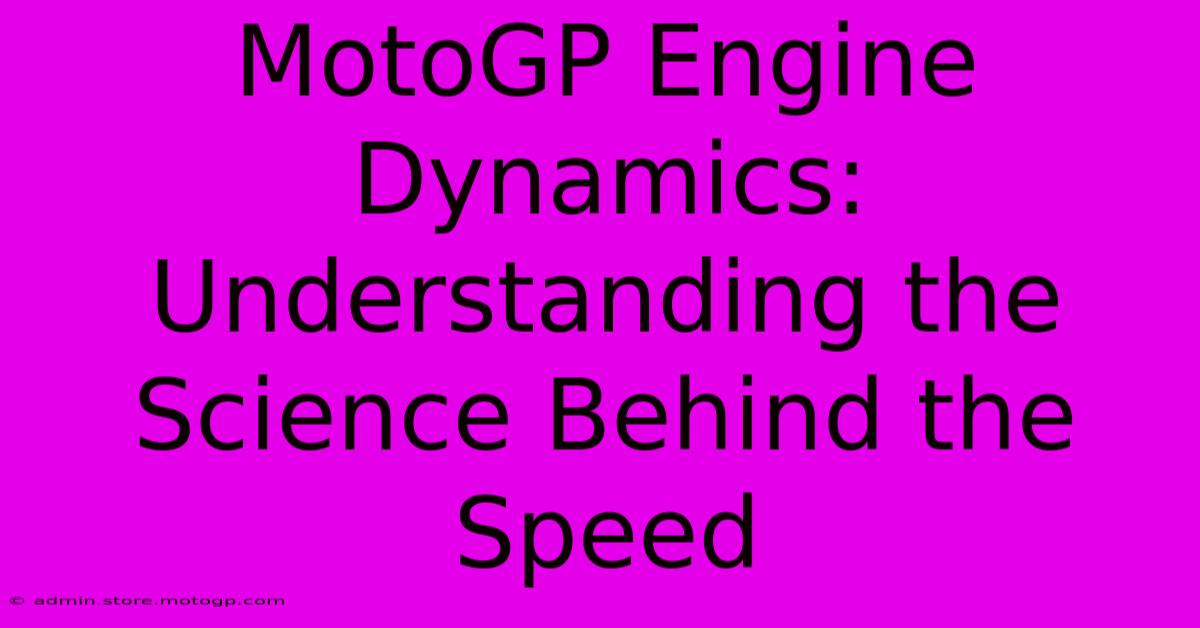MotoGP Engine Dynamics: Understanding The Science Behind The Speed

Table of Contents
MotoGP Engine Dynamics: Understanding the Science Behind the Speed
MotoGP. The name itself evokes images of screaming engines, breathtaking speeds, and the ultimate test of rider skill. But behind the spectacle lies a complex interplay of engineering marvels, with the engine at its very heart. This article delves into the fascinating world of MotoGP engine dynamics, exploring the science that propels these machines to the edge of performance.
The Powerhouse: MotoGP Engine Specifications
MotoGP bikes boast incredibly sophisticated engines, currently limited to 1000cc four-stroke prototypes. These aren't your average road bikes; they're meticulously engineered for maximum power and efficiency on the track. Let's look at some key features:
- High RPM capabilities: MotoGP engines rev to incredibly high RPMs, typically exceeding 16,000 RPM, far surpassing road-going motorcycles. This high rev range maximizes power output within the engine's displacement limits.
- Extreme Lightweight Construction: Every gram counts in MotoGP. Engines are built using exotic materials like titanium and magnesium alloys to reduce weight, improving handling and acceleration.
- Sophisticated Valve Train: These engines employ complex valve train systems, often pneumatic, to ensure precise valve timing at high RPMs for optimal combustion.
- Precision Fuel Injection: Precise fuel injection systems deliver the exact amount of fuel to each cylinder at the optimal time, crucial for maximizing power and efficiency.
- Seamless Gearboxes: Seamless shift technology allows for incredibly fast gear changes without interrupting power delivery, a vital factor for maintaining speed through corners.
Understanding the Physics: From Combustion to Motion
The power generated by a MotoGP engine is a result of controlled explosions within the cylinders. The process can be broken down as follows:
- Intake: The piston draws in a carefully metered mixture of air and fuel.
- Compression: The piston compresses the mixture, increasing its temperature and pressure.
- Combustion: A spark ignites the compressed mixture, causing a rapid expansion of gases.
- Power Stroke: This expansion forces the piston downwards, creating the power that drives the crankshaft.
- Exhaust: The spent gases are expelled from the cylinder, making way for the next cycle.
The efficiency of this process is paramount. Factors like air intake design, fuel injection precision, and exhaust system optimization all play crucial roles in maximizing power output.
Beyond the Engine: The Whole System Matters
While the engine is the heart of the machine, its performance is inextricably linked to other systems. Consider:
- Aerodynamics: MotoGP bikes are masterpieces of aerodynamic design, reducing drag and generating downforce for increased stability at high speeds.
- Chassis & Suspension: The chassis and suspension systems work in harmony with the engine to provide optimal handling and stability, allowing riders to push the limits through corners.
- Electronics: Sophisticated electronic control units (ECUs) manage various engine parameters, including fuel injection, ignition timing, and traction control, optimizing performance and rider safety.
The Importance of Data Analysis
MotoGP teams utilize vast amounts of data collected during testing and races. This data, covering engine performance, rider inputs, and environmental conditions, informs crucial decisions about engine tuning and overall bike setup. Advanced simulations and modeling play a key role in optimizing the performance of these highly complex machines.
The Future of MotoGP Engine Technology
The quest for ever-increasing performance continues. Future developments may include:
- Hybrid powertrains: The integration of hybrid technology could enhance performance and efficiency.
- Advanced materials: The ongoing search for lighter, stronger, and more heat-resistant materials will undoubtedly improve engine durability and performance.
- Artificial Intelligence (AI): AI-powered optimization of engine parameters in real-time could lead to even greater performance gains.
Conclusion:
The MotoGP engine is a testament to human ingenuity and engineering prowess. Understanding its dynamics, from the fundamental principles of combustion to the sophisticated electronics that control it, provides a fascinating glimpse into the cutting-edge technology that drives these incredible machines to their limits. The relentless pursuit of speed and efficiency in MotoGP continues to push the boundaries of what's possible, promising even more thrilling races in the years to come.

Thank you for visiting our website wich cover about MotoGP Engine Dynamics: Understanding The Science Behind The Speed. We hope the information provided has been useful to you. Feel free to contact us if you have any questions or need further assistance. See you next time and dont miss to bookmark.
Featured Posts
-
Witness Moto Gps Global Domination On Nbc
Feb 19, 2025
-
Motorcycle Racing Categories Promoting Sportsmanship
Feb 19, 2025
-
Dominate The Track Understanding Moto2 Bike Specifications
Feb 19, 2025
-
Moto Gp Crash Today The Impact On The Sport
Feb 19, 2025
-
Moto Gp Sprint A Must Have For Any Racing Fan
Feb 19, 2025
